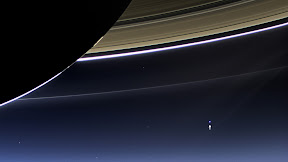
Launched in 1997, NASA’s Cassini space probe arrived in Saturn orbit in 2004 and has provided valuable insight into the sixth planet in our solar system as well as others. On July 19 of this year the spacecraft took an extraordinary image of our home planet and moon as seen from nearly 900 miles away.
The image captured the planet around which Cassini is orbiting, its infamous rings and off in the distance, the planet Earth and our moon. The pale blue hue of our planet is almost unmistakable among the features in the photo. It truly does make one feel small when compared to the immensity of the heavens above.
NASA’s press release says in part:
“In the Cassini images Earth and the moon appear as mere dots — Earth a pale blue and the moon a stark white, visible between Saturn’s rings. It was the first time Cassini’s highest-resolution camera captured Earth and its moon as two distinct objects.
“It also marked the first time people on Earth had advance notice their planet’s portrait was being taken from interplanetary distances. NASA invited the public to celebrate by finding Saturn in their part of the sky, waving at the ringed planet and sharing pictures over the Internet. More than 20,000 people around the world participated.
“”We can’t see individual continents or people in this portrait of Earth, but this pale blue dot is a succinct summary of who we were on July 19,” said Linda Spilker, Cassini project scientist, at NASA’s Jet Propulsion Laboratory in Pasadena, Calif. “Cassini’s picture reminds us how tiny our home planet is in the vastness of space, and also testifies to the ingenuity of the citizens of this tiny planet to send a robotic spacecraft so far away from home to study Saturn and take a look-back photo of Earth.”
“Pictures of Earth from the outer solar system are rare because from that distance, Earth appears very close to our sun. A camera’s sensitive detectors can be damaged by looking directly at the sun, just as a human being can damage his or her retina by doing the same. Cassini was able to take this image because the sun had temporarily moved behind Saturn from the spacecraft’s point of view and most of the light was blocked.”

